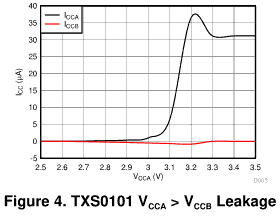A question has come up regarding the TXS0102-Q1; Specifically regarding the note about “A VCCA value greater than or equal to VCCB (VCCA ≥ VCCB) does not damage the device, but during operation, VCCA must be less than or equal to VCCB (VCCA ≤ VCCB) at all times.”
There are some instances in the this design where VCCA and VCCB are both at 3V3 but sourced from 2 separate power domains, with slight variations that can be expected on either rail. Hence there will not likely be a way to guarantee VCCA <= VCCB.
My question is what is the impact when the VCCA ≤ VCCB condition is not met? Do you have any recommendations for devices that can be used alternatively for this application?


